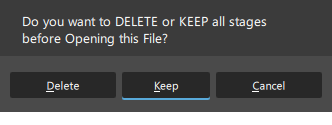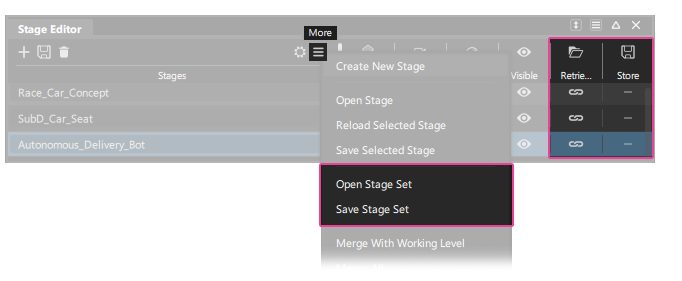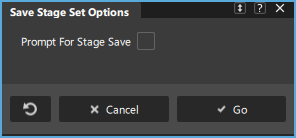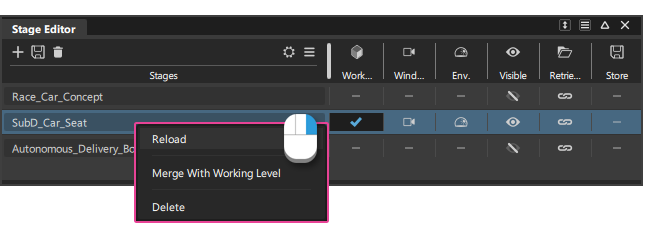Stages
![]()
The Stage Editor lists all the .wire files that are currently open in the application. Each opened .wire file has an associated stage.
Additional stages are typically created when File > Open is used and Keep is selected in the dialog window. Having multiple stages allows you to keep many models open in the application at once and quickly switch between them.
Only one stage can be the active Working Level stage. Inactive stages display in a pale green wireframe color when visible.
Use the Stage Editor to:
- Set the working level (active) stage.
- Control the visibility of each stage.
- Rename stages
- Re-order stages
- Mix window and environment sources across stages.
- Specify Stage Set save options with Auto Retrieve and Wire Store settings.

Editor icon bar
![]()
![]() - Open - Access the Open menu items:
- Open - Access the Open menu items:
- Create New Stage - Creates an empty new stage, adds it to the editor, and sets it as the Working Level stage. There is no reference to a .wire file until it is saved to disk.
- Open Stage - Opens a .wire file as a new stage, adds it to the editor, and sets it as the Working Level stage. This has a benefit over using File > Open from the main menu as the dialog window asking whether to Delete or Keep previous stages is not needed.
- Open Stage Set - Duplicate of the File > Open Stage Set command. Opens a saved .stg file and recreates the list of stages specified. Note that the .wire files associated with each stage are only loaded if Auto Retrieve was selected in the Stage Editor when Save Stage set was used to create the .stg file.
![]() - Save - Access the Save menu items:
- Save - Access the Save menu items:
- Save Selected Stage - Duplicate of the File > Save As command. Saves the geometry in the selected stage to a .wire file. Select a stage by clicking on the name to highlight the row with a blue background. Note that this is not necessarily the same as the Working Level stage.
- Save Stage Set - Duplicate of the File > Save Stage Set As command. Saves the list of stages in the Stage Editor as a .stg. file.
![]() - Delete - Access the Delete menu items:
- Delete - Access the Delete menu items:
Delete Selected Stage - Select a stage by clicking on the name to highlight the row with a blue background. Alternatively use the context menu Delete command (RMB).
Delete All Stages - Deletes all stages, leaving a default, empty stage only.
Note: deleting stages does not save any changes that have been made to the geometry. Make sure you save any required changes before using the delete stages tools.
![]() - Settings - Access the Setting menu items:
- Settings - Access the Setting menu items:
- No Preview, Small Preview, Large Preview - Choose whether or not to display a preview image of the stage contents and select a preview size.
- Show Stage Name - Display the stage name for each list item.
- Show File Path - Display the path for the .wire file that has been opened into the stage.
![]() - More - The More menu has duplicates of the icon bar and context menu tools plus one unique tool:
- More - The More menu has duplicates of the icon bar and context menu tools plus one unique tool:
- Merge All - Merges all the stages in the Stage Editor into the Working Level stage.
List item tools

The Stage Editor tools appear in the columns for each stage listed in the editor.
 Name
Name
Displays the stage name or the .wire file name (and path).
Choose the display type (Stage name or File path) in the Settings menu
 .
.When a .wire file is opened, the stage name defaults to the same name as the .wire file (possibly with a suffix if the file has been previously opened).
Use the middle mouse button (MMB) to drag-and-drop a row to re-order the stages in the list.
Double-click on a name to change it.
Changing the reference path changes the name of the .wire file when saved. It also changes the stage name.
The stage name can be changed during a session by double-clicking on the name, but the changes are saved with the .wire file.
 Preview thumbnail
Preview thumbnail
When Show Preview is on in the Settings menu ![]() , a small thumbnail image of the geometry is shown next to the stage name.
, a small thumbnail image of the geometry is shown next to the stage name.
 Working Level
Working Level 
Sets which stage is active:
Only one stage at a time can be the Working Stage where geometry can be created, selected, and modified.
Objects on inactive stages display in pale green (if visibility is on for that stage).
If you are in the middle of geometry operations, such as building a curve or selecting curves for a rail surface, switching the Working Level stage will restart the tool.
 Window Source
Window Source 
Sets which stage is providing the view windows for the scene.
Only one stage at a time can be the Window Source.
If you create a perspective or orthographic window, it belongs to the stage that is the current Window Source (which might not be the working stage).
The application of Hardware Shade is a part of the window definition and so may change when Window Source is changed.
Using
Alt+ LMB to select the Working Level switches all settings to the working level stage, including the Window Source.
 Env Source
Env Source 
Sets which stage is providing the environment shader for the scene.
Only one stage at a time can be the Environment Source.
If the Environment Source is not from the same stage as the Working Level, you need to switch the Working Level to the same stage as the Environment Source to make changes to the environment shader.
Using
Alt+ LMB to select the Working Level switches all settings to the working level stage including the Environment Source.
 Visible
Visible 
Sets which stages are visible in the scene.
All stages can be invisible except for the Working Level.
When a stage is not set as the Working Level stage but set to visible, the geometry displays as pale green wireframe.
Using
Alt+ LMB to select the Working Level turns visibility off for all stages except the Working Level stage.The icon at the top can be used as a menu to turn all stages visible or invisible (excluding the Working Level stage).

 Auto Retrieve
Auto Retrieve 
The Auto Retrieve setting is applied when Save Stage Set is used.
On - When Open Stage Set is used, the stages and the associated wire files are re-loaded into the application.
Off - When Open Stage Set is used, only the stages are re-loaded into the application, and Reload Selected Stage needs to be used to open a .wire file into a stage.
The icon at the top can be used as a menu to set all stages to Auto Retrieve on or off.
 Wire Store
Wire Store 
The Wire Store setting is applied when Save Stage Set is used.
On - Saves the .wire file when the stage set is saved.
A white padlock icon means that you do not have write permissions and you cannot save this stage.
If a stage does not have a referenced .wire file (for example if Create New Stage has been used followed by some geometry creation), a default name for the .wire file is supplied based on the stage name.
Off - The .wire file is not be saved when the stage set is saved. Therefore, it is not be overwritten accidentally, and any changes made to the stage are not saved.
The icon at the top can be used as a menu to set all stages to Wire Store on or off.
Workflow - About Stages
There is a one-to-one relationship between a stage and a .wire file, and the distinction is a technical one for managing the model data:
- .wire file - the model data saved to disk in a machine-readable format.
- Stage - the model 'unpacked' into the Alias application and displayed as 3D geometry that the user can interact with.
Typically the Stage name is the same as the .wire file name, and both are displayed on the application header bar:

Creating multiple stages
Having multiple Stages means you can keep more than one model open at a time in the application and quickly switch between them (using the Stage Editor or the Stage shortcut menu).
Multiple stages are typically created during the File > Open process when responding to the File > Open dialog box:

Choosing Delete when using File > Open ensures that you open just one model at a time. There will still be a Stage associated with the opened .wire file, but it is simply a technical requirement and has no use for the user.
Choosing Keep when using File > Open keeps the previous .wire file(s) and adds the new file as an additional stage listed in the Stage Editor. The newly opened file is set as the Working Stage.
Alternatively, in the Stage Editor, use
 Open > Open Stage to open a .wire file as a new stage, which is added to the Stage Editor and set as the Working Stage. This has a benefit of not requiring the Delete/Keep dialog window each time you open a .wire file.
Open > Open Stage to open a .wire file as a new stage, which is added to the Stage Editor and set as the Working Stage. This has a benefit of not requiring the Delete/Keep dialog window each time you open a .wire file.
Stages shortcut menu
The Stages shortcut menu is on the promptline and can be used to:
- Open the Stage Editor.
- Switch the Working Level to a stage in the list using the LMB.
- Exclusively switch all settings to a stage in the list using
Alt+ LMB.

Assemblies, stages and the Reference Manager
The Reference Manager is typically used instead of the Stage Editor for working with assembly type models for the following reasons:
Different stages cannot be shaded at the same time using Hardware Shade. Only the Working Level stage is shaded.
If some components of an assembly are being worked on by others, the Reference Manager highlights and manages any updates.
The Reference Manager can manage large data sets while maintaining interaction performance.
If stages and the Reference Manager are used in the same session, reference files belong to the stage they were imported to and do not work across stages.
Workflow - Working with stages
Workflow 1 - Working on many unrelated projects
In a busy design studio, you may be working on different, unrelated projects throughout the day. Using stages means you can keep more than one model open at a time and quickly switch between them.
In this workflow you will typically switch all settings so that the each model is viewed as if it was the only file open.
Use Alt + LMB (Switch Stage Exclusive) on the Working Level checkmark or stage name in the editor to:
- Set the Working Level to the selected stage and make it visible.
- Turn Visibility off for all other stages.
- Set the Window Source and Environment Source to the selected stage.
The Alt + LMB exclusive switch can also be used on the Stages shortcut menu.


Workflow 2 - Working on related components of a project
All stages share the same world axes, so the Working Level stage can be viewed in context, with other inactive stages displayed in pale green. It can also be useful to maintain a consistent viewpoint and view windows when changing the Working Level to work on a different component.
The typical workflow would be to only change the working level and leave all stages visible. The Window Source and Environment Source are typically unchanged, but they can be set in the Stage Editor if required.
To only switch the Working Level:
In the Stage Editor select the Working level check mark.
In the Stages shortcut menu use LMB only to select the stage from the list.
If you create a perspective or orthographic window, it belongs to the stage that is the current Window Source, which might not be the Working Stage.


Workflow 3 - Using a Stage for visualizing alternative models
When shading a model, one technique is to create a stage environment. Each model (in separate stages) is then visualized using the same view, lighting, and environment. In this case, keep the Window Source (and the Environment Source) set to the scene stage, and only switch the Working Level between the different model stages.
To make changes to the environment shader, set the Working Level to the stage with Environment Source selected.


Tips for working with stages
When using File > Open, if you select many files at the same time then they are all loaded into the scene as separate stages. If the .wire files have been saved with different Construction Options settings, then you will see the Construction Options retrieve dialogue box for each file.
To switch stages using hotkeys, assign hotkeys to the Toggle Stage and Toggle Stage Exclusive functions in the Special > Display Functions section of the Hotkey Editor Preferences > Hotkeys/Menu Editor.
When you exit Alias, a prompt window appears for each stage to check whether you want to save them or not. If the stage has just been saved then the prompt window does not appear for that stage.
Workflow - Working with Stage Sets (Advanced)
There are two tools for working with Stage Sets:
File > Save Stage Set - Saves a text file with a .stg suffix, which lists the stages and settings in the Stage Editor.
File > Open Stage Set - Re-opens the list of .wire files in one operation.
A Stage Set is a saved text file with a .stg suffix and lists the stages and their settings in the Stage Editor. This can be used to re-open the same set of .wire files in one operation using File > Open Stage Set.
These tools are also available in the Stage Editor along with the Auto Retrieve and Wire Store settings that apply when stages are saved:

When you save a Stage Set, the Wire Store column settings apply:
Wire Store off (default) - The .wire file is not saved when the Stage Set is saved (only the list of stages in the set is saved).
In this case, you are responsible for choosing whether or not to save any changes to your model by setting the stage to the Working LOevel and using File > Save or Save As. In this case, Save Stage Set is only saving the list of stage. The .wire files and any changes made to the geometry are not saved.
Wire Store on - The .wire file is saved when the Stage Set is saved.
 tool in the main menu has the option of prompting the user to choose whether to save each .wire file. This can be useful when using the default setting of Wire Store off as it prompts you to make decisions on saving each of the loaded .wire files.
tool in the main menu has the option of prompting the user to choose whether to save each .wire file. This can be useful when using the default setting of Wire Store off as it prompts you to make decisions on saving each of the loaded .wire files.
Opening Stage Sets
When using Open Stage Set, the Auto Retrieve settings when Save Stage Set was used are applied:
Auto Retrieve on (default) - When you use Open Stage Set, the .wire files are also retrieved and loaded into the stages.
Auto Retrieve off - You need to manually load your chosen .wire file into the retrieved stages using Reload Selected Stage from the Open menu in the Stage Editor icon bar.
When using Open Stage Set, you get the same dialog windows as you get with File > Open:
Keep or delete any current stages. Selecting Keep allows you to open many stage sets into one session.
The Construction Options dialog box appears for each file with different settings as they are opened.

